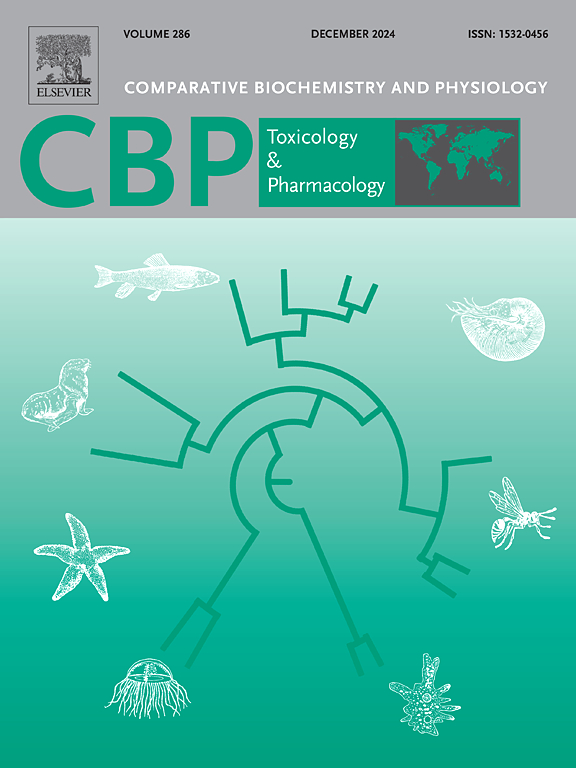Adolescent marginal zinc deficiency upregulated BDNF and TrkB expression, impaired hippocampal and cortical development, and induced abnormal behaviors in male mice
IF 3.9
3区 环境科学与生态学
Q2 BIOCHEMISTRY & MOLECULAR BIOLOGY
Comparative Biochemistry and Physiology C-toxicology & Pharmacology
Pub Date : 2025-03-26
DOI:10.1016/j.cbpc.2025.110197
引用次数: 0
Abstract
Zinc deficiency during adolescence poses a significant yet understudied risk to brain development. The study aimed to investigate the effects of marginal zinc deficiency during adolescence on emotion and cognition, morphological changes and neuronal arrangement of hippocampus and cortical, and proBDNF, mBDNF and TrkB expression levels. The emotion was assessed using the open-field test and three-chamber test. Additionally, cognition was evaluated using the Morris water maze test and novel object recognition test. Morphological changes were evaluated using H&E staining, while Nissl staining was employed to analyze neuronal arrangement. Additionally, proBDNF, mBDNF and TrkB expression levels were quantified by western blot. The results showed that adolescent marginal zinc deficiency induced risk-taking behavior, impaired spatial learning and memory, and caused new object recognition deficits without affecting sociability. Moreover, marginal zinc deficiency critically disrupted hippocampal and cortical development, and aberrant neuronal arrangement. The expression levels of BDNF for both form states were not statistically significant upregulation in marginal zinc deficiency mice compared to controls, along with significantly increased TrkB expression. These findings suggested that adolescent marginal zinc deficiency increased the expression of BDNF and TrkB, as well as abnormal hippocampal and cortical development. These alterations may explain the observed abnormal behavior, including risk-taking behavior, impaired spatial learning and memory, and new object recognition decay.

青春期边缘缺锌会上调 BDNF 和 TrkB 的表达,损害海马和大脑皮层的发育,并诱发雄性小鼠的异常行为。
青春期缺锌会对大脑发育造成重大风险,但尚未得到充分研究。本研究旨在探讨青春期边缘性锌缺乏对青少年情绪认知、海马和皮质的形态学改变和神经元排列以及proBDNF、mBDNF和TrkB表达水平的影响。情绪评估采用开场测试和三室测试。此外,采用Morris水迷宫测验和新物体识别测验评估认知能力。H&E染色观察细胞形态变化,尼索染色观察神经元排列。western blot检测proBDNF、mBDNF和TrkB的表达水平。结果表明:青少年边缘性锌缺乏可诱发冒险行为、空间学习记忆障碍和新物体识别缺陷,但不影响社交能力;此外,边缘性锌缺乏严重破坏了海马和皮层的发育,并导致神经元排列异常。与对照组相比,边缘缺锌小鼠两种状态下BDNF的表达水平均无统计学意义的上调,TrkB的表达也显著增加。这些结果表明,青少年边缘锌缺乏增加了BDNF和TrkB的表达,以及海马和皮质发育异常。这些变化可以解释观察到的异常行为,包括冒险行为、空间学习和记忆受损以及新物体识别衰退。
本文章由计算机程序翻译,如有差异,请以英文原文为准。
求助全文
约1分钟内获得全文
求助全文
来源期刊
CiteScore
7.50
自引率
5.10%
发文量
206
审稿时长
30 days
期刊介绍:
Part C: Toxicology and Pharmacology. This journal is concerned with chemical and drug action at different levels of organization, biotransformation of xenobiotics, mechanisms of toxicity, including reactive oxygen species and carcinogenesis, endocrine disruptors, natural products chemistry, and signal transduction with a molecular approach to these fields.

 求助内容:
求助内容: 应助结果提醒方式:
应助结果提醒方式:


